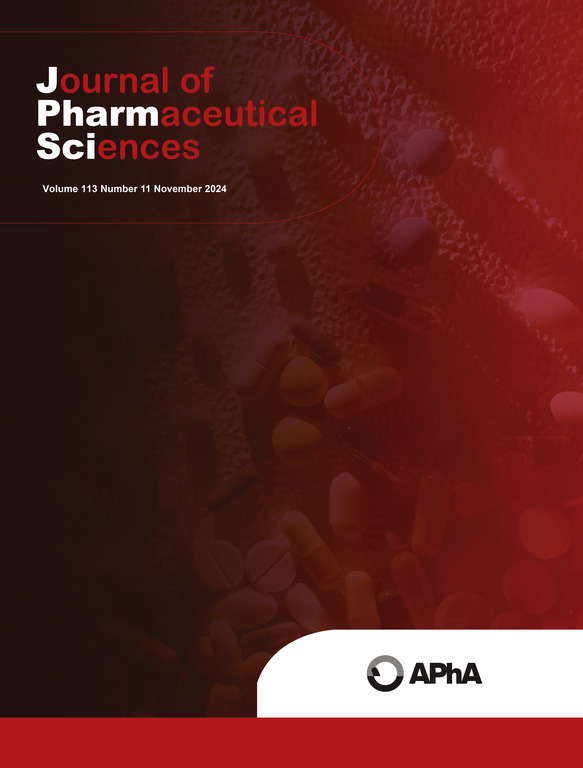Preparation and characteristics of novel Jerusalem artichoke polysaccharides-based polymeric micelles for poorly water-soluble drug delivery
IF 3.8
3区 医学
Q2 CHEMISTRY, MEDICINAL
引用次数: 0
Abstract
To develop a novel Jerusalem artichoke polysaccharide (JAP)-based delivery system for poorly water-soluble drugs (PWSDs), JAP-SA polymer and florfenicol (FFC)/JAP-SA polymer micelles were prepared. The preparation process was optimized using response surface methodology, with encapsulation efficiency (EE) and drug loading capacity (DLC) as evaluation criteria. Under the optimized conditions [mass ratio of FFC to JAP-SA (1:1), stirring time (5.4 h), and stirring speed (700 r/min)], the EE and DLC reached 69.11 ± 2.04% and 11.99 ± 2.02%, respectively. SEM, TEM, and laser diffraction particle size analysis revealed that the drug-loaded micelles exhibited a unimodal size distribution with an average diameter of 198.33 ± 0.25 nm and a near-spherical morphology. The micelles demonstrated favorable stability, blood compatibility, and cytocompatibility, as assessed through stability testing (STS), erythrocyte hemolysis assay (EHT), and MTT assay. The critical micelle concentration (CMC) of the FFC/JAP-SA micelles, as determined by pyrene fluorescence spectroscopy (PFS), was 19.92 ± 2.01 µg/mL in water and 10.96 ± 1.18 µg/mL in phosphate-buffered saline (PBS). In vitro release studies showed that the FFC/JAP-SA micelles provided sustained drug release in both simulated gastric fluid (SGF, pH 1.2) and simulated intestinal fluid (SIF, pH 6.8), with release kinetics indicating acid-responsive behavior. Additionally, antibacterial efficacy was observed to be concentration-dependent. Pharmacokinetic analysis yielded a time to peak concentration (Tmax) of 1.00 ± 0.18 h, a mean residence time (MRT0-t) of 8.34 ± 0.68 h, and an elimination half-life (T1/2β) of 2.93 ± 2.72 h. These results demonstrate that the FFC/JAP-SA micelles significantly enhanced the aqueous solubility of encapsulated FFC compared to FFC powder, thereby establishing a promising foundation for improving therapeutic efficacy and reducing side effects associated with PWSDs.
新型菊芋多糖聚合物胶束的制备及性能研究。
以菊芋多糖(JAP)为基础,制备了JAP- sa聚合物和氟苯尼考(FFC)/JAP- sa聚合物胶束,制备了一种新型的低水溶性药物给药体系。以包封率(EE)和载药量(DLC)为评价标准,采用响应面法对其制备工艺进行优化。在FFC与JAP-SA质量比为1:1、搅拌时间为5.4 h、搅拌速度为700 r/min的优化条件下,EE和DLC分别达到69.11±2.04%和11.99±2.02%。扫描电镜(SEM)、透射电镜(TEM)和激光衍射粒度分析表明,载药胶束的粒径呈单峰分布,平均直径为198.33±0.25 nm,形貌为近球形。通过稳定性测试(STS)、红细胞溶血试验(EHT)和MTT试验评估,胶束表现出良好的稳定性、血液相容性和细胞相容性。芘荧光光谱(PFS)测定FFC/JAP-SA胶束的临界胶束浓度(CMC)在水中为19.92±2.01µg/mL,在磷酸盐缓冲盐水(PBS)中为10.96±1.18µg/mL。体外释放研究表明,FFC/JAP-SA胶束在模拟胃液(SGF, pH 1.2)和模拟肠液(SIF, pH 6.8)中均能持续释放药物,且释放动力学显示酸响应行为。此外,抗菌效果观察到浓度依赖性。药代动力学分析结果显示,FFC/ jjapa - sa胶束的峰浓度时间(Tmax)为1.00±0.18 h,平均停留时间(MRT0-t)为8.34±0.68 h,消除半衰期(T1/2β)为2.93±2.72 h。这些结果表明,与FFC粉末相比,FFC/ jjapa - sa胶束可显著提高FFC包封后的水溶性,从而为提高治疗效果和减少PWSDs相关副作用奠定了良好的基础。
本文章由计算机程序翻译,如有差异,请以英文原文为准。
求助全文
约1分钟内获得全文
求助全文
来源期刊
CiteScore
7.30
自引率
13.20%
发文量
367
审稿时长
33 days
期刊介绍:
The Journal of Pharmaceutical Sciences will publish original research papers, original research notes, invited topical reviews (including Minireviews), and editorial commentary and news. The area of focus shall be concepts in basic pharmaceutical science and such topics as chemical processing of pharmaceuticals, including crystallization, lyophilization, chemical stability of drugs, pharmacokinetics, biopharmaceutics, pharmacodynamics, pro-drug developments, metabolic disposition of bioactive agents, dosage form design, protein-peptide chemistry and biotechnology specifically as these relate to pharmaceutical technology, and targeted drug delivery.

 求助内容:
求助内容: 应助结果提醒方式:
应助结果提醒方式:


